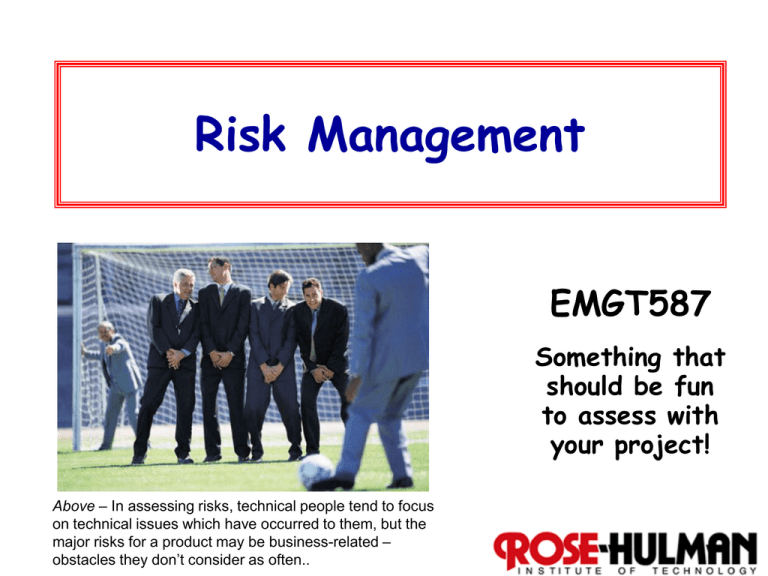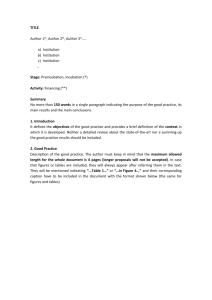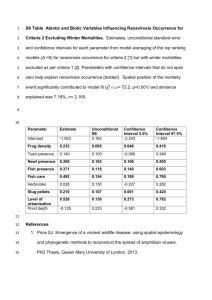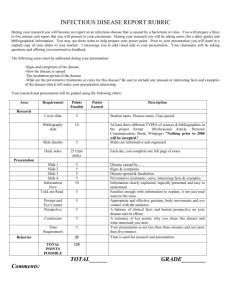Risk Management - Rose
advertisement

Risk Management EMGT587 Something that should be fun to assess with your project! Above – In assessing risks, technical people tend to focus on technical issues which have occurred to them, but the major risks for a product may be business-related – obstacles they don’t consider as often.. 1 Risk Definition • Risk is the potential that something will go wrong as a result of one or a series of events. • Measured as the combined effect of the probability of occurrence and the assessed consequences of the occurrence. 2 Risk Management Definition • Risk management is an organized method for identifying and measuring risk and for selecting and developing options for handling risk. • Basic Elements are: Assessment – Risk Assessment – Risk Analysis – Risk Abatement Risk Analysis Abatement 3 Risk Assessment • Risk assessment involves the ongoing review of technical design and/or program management decisions, and the identification of potential areas of risk. 4 Risk Analysis • Risk analysis includes analyzing the probability of events and the consequences associated with their occurrence. – Event → Cause → Effects → Risk level. • Tools Include – Network analysis, Fishbone, FMEA, Hazard Analysis, etc. 5 Risk Abatement • Planning for risk. Techniques and methods to reduce or control the risk. • Identify and monitor high risk items or areas more closely or frequently. 6 Areas of Risk • Project areas of risk can include: – Technical, Not meeting a design requirement – Schedule, – Resources, – Personnel, – Budget, – Political 7 Risk Models • At the Project or System level • At the Component or Subsystem level For the soda machine: 1. In an overall sense, is this a high risk project? 2. Where are the areas of high risk, which modules, what functionality ? 8 Risk Models- System Level • Quantitative models incorporating: – Probability of occurrence, Pi – Consequences of occurrence, Ci. • Models often tailored to circumstances. • Risk Factor Rf = Pf + Cf – PfCf – Defense Systems Management College model. 9 Risk Model • Risk Model Categories and Weights • Risk Analysis and Reporting 10 ‘Probability/Consequence’ Approaches are Common 11 Example Project Design 1. System design uses off-the-shelf hardware with minor modifications to the software. 2. The design is relatively simple involving the use of standard hardware. 3. The design requires software of somewhat greater complexity. 4. The design requires a new database to be developed by a subcontractor. 5. The consequences of this items failure due to technical factors causes problems of a corrective nature, but the correction causes an 8% cost increase and a 2 month schedule slip. 12 Risk Model Tables Pf is the ‘probability of failure’ term 13 Risk Model Tables (cont) Ct Cf is the ‘consequence’ of the failure term 14 Risk Model Tables (cont) 15 Risk Model Process/Decision 16 Example Project Design (cntd) 1. System design uses off-the-shelf hardware with minor modifications to the software. 2. The design is relatively simple involving the use of standard hardware. 3. The design requires software of somewhat greater complexity. 4. The design requires a new database to be developed by a subcontractor. 5. The consequences of this items failure due to technical factors causes problems of a corrective nature, but the correction causes an 8% cost increase and a 2 month schedule slip. 17 Calculations Factors Weights PMhw 0.1 0.2 PMsw 0.3 0.1 PChw 0.1 0.4 PCsw 0.3 0.1 Pd 0.9 0.2 Pf 0.3 Ct 0.3 0.4 Cc 0.5 0.5 Cs 0.3 0.1 Cf 0.4 RF 0.58 This is a Medium Risk Project 18 Benefits of the Risk Model • Identify overall project risk. • Identify areas of the project for closer tracking and monitoring. 19 Risk Abatement-1 • Accept, Assign, Eliminate, Reduce, or Control the Risk • Possible Actions: – – – – Just live with it…. Assign to someone else (insurance) .. Redesign the system for lower risk. If risk concentrated in one subsystem, allocate it differently. – If risk spread throughout the system, concentrate it in a few. 20 Risk Abatement-2 • Eliminate, Reduce, or Control the Risk • Possible Actions: – Increased management reporting and review, – Allocate more resources, – Adjust schedules, – Hire consultants or specialists, – Implement testing plan to identify causes, – Start special R&D activities, – Develop a ‘Plan B or fall-back’ plan. 21 Risk Management in Large-Scale Systems Characteristics 1. Simultaneous Autonomy and Interdependence 2. Intended and Unintended Consequences 3. Long Incubation Periods 4. Risk Migration 22 Simultaneous Autonomy and Interdependence • Sub-systems function independently and are responsible for their own survival and growth. • Yet are linked with other systems. • Actions to reduce risk at the subsystem level might increase risk at the system level. 23 Intended and Unintended Consequences • Due to complexity, size, and interactions in systems and projects– decisions have intended and unintended consequences. • Decisions made with imperfect data and sometimes ‘negotiated’. 24 Long Incubation Periods • Accidents and disasters (failure to see risks) often have long incubation periods: – Events often signal danger during incubation period – but ignored or overlooked. – The longer unnoticed, • more difficult to recognized them, • more difficult to correct them. 25 Risk Migration • Long incubation periods present opportunities for risk to migrate to other subsystems and parts of the project. 26 Focus Items for Risk Mitigation Organizational excellence at: – Communication • Make ‘autonomy and interdependence’ explicit. – Decision Making • Ownership, ‘buck stops everywhere’. – Culture • Oversight, strong norms, checks/balances. • Multiple authority structures. – Interfaces 27 Risk Maturity Levels Definition Culture Level 1 – Ad Hoc Level 2 – Initial Unaware of the need for management of uncertainties (risk). No structured approach to dealing with uncertainty. Repetitive and reactive management processes. Little or no attempt to learn from past projects or prepare for future projects. No risk awareness. No upper management involvement. Resistant/reluctance to change. Tendency to continue with existing processes even in the face of project failures. Shoot the messenger. Experimenting with risk management through a small number of individuals. No structured approach in place. Aware of potential benefits of managing risk, but ineffective implementation. Management of uncertainty built into all organizational processes. Risk management implemented on most or all projects. Formalized generic risk process. Benefits understood at all organizational levels, although not always consistently achieved. Risk-aware culture with proactive approach to risk management in all aspects of the organization. Active use of risk information to improve organizational processes and gain competitive advantage. Risk process may be viewed as additional overhead with variable benefits. Upper management encourages, but does not require, use of Risk Management. Risk management used only on selected projects. No generic formal processes, although some specific formal methods may be in use. Process effectiveness depends heavily on the skills of the project risk team and the availability of external support. All risk personnel located under project. Accepted policy for risk management. Benefits recognized and expected. Upper Management requires risk reporting. Dedicated resources for risk management. “Bad news” risk information is accepted. Top-down commitment to risk management, with leadership by example. Upper management uses risk information in decision-making. Proactive risk management encouraged and rewarded. Organizational philosophy accepts idea that people make mistakes. Risk-based organizational processes. Risk Management culture permeating the entire organization. Regular evaluation and refining of process. Routine risk metrics used with consistent feedback for improvement. Key suppliers and customers participate in the Risk Management process. Direct formal communication channel to organization management. Process No formal process. No Risk Management Plan or documented process exists. None or sporadic attempts to apply Risk Management principles. Attempts to apply Risk Management process only when required by customer. Experience No understanding of risk principles or language. No understanding or experience in accomplishing risk procedures. Limited to individuals who may have had little or no formal training. Application No structured application. No dedicated resources. No risk management tools in use. No risk analysis performed. Inconsistent application of resources. Qualitative risk analysis methodology used exclusively Level 3 – Repeatable Generic processes applied to most projects. Formal processes incorporated into quality system. Active allocation and management of risk budgets at all levels. Limited need for external support. Risk metrics collected. Key suppliers participate in Risk Management process. Informal communication channel to organization management. In-house core of expertise, formally trained in basic risk management skills. Development and use of specific processes and tools. Routine and consistent application to all projects. Dedicated project resources. Integrated set of tools and methods. Both qualitative and quantitative risk analysis methodologies used. Level 4 - Managed All staff risk aware and capable of using basic risk skills. Learning from experience as part of the process. Regular training for personnel to enhance skills. Risk ideas applied to all activities. Risk-based reporting and decisionmaking. State-of-the-art tools and methods. Both qualitative and quantitative risk analysis methodologies used with great stress on having valid and reliable historical data sources. Dedicated organizational resources. 28 Exercise : Company X • Company X is a small entrepreneurial company, three years old, selling monitoring products and systems into an emerging industrial and technical market. The company faces a decision to select a product development direction for the next generation of the companies’ product lines. Two major directions and product platforms have been proposed and are being considered. • See the case writeup for more details (the doc file in Week08 stuff). 29 Exercise : Company X • What are the risk scores for each option? • Where are areas of high risk? • What would a risk management plan look like for each option (develop an outline) ? 30








